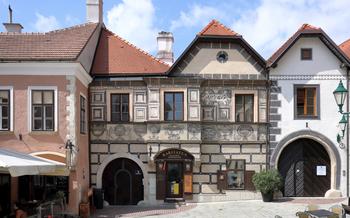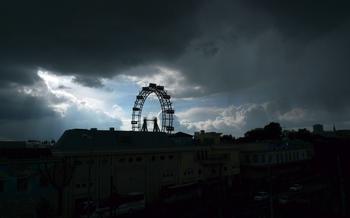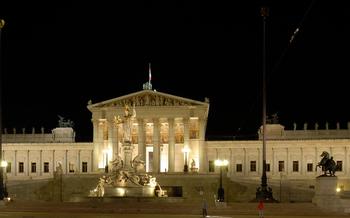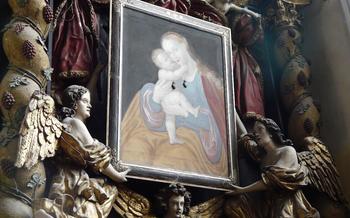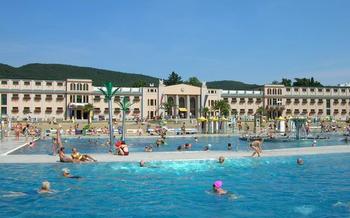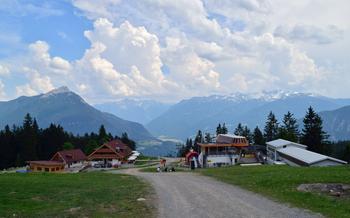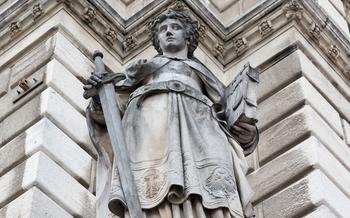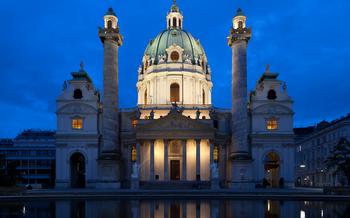
The Third Man Museum
- The Third Man Museum: A Journey Through Post-War Vienna
- Exploring the Museum's Unique Atmosphere
- Uncovering the Secrets of the Sewers
- Following in the Footsteps of Harry Lime
- Tracing the Locations Featured in the Film
- Exploring the City's Iconic Landmarks
- Discovering the Real-Life Inspirations Behind the Film's Characters
- Unveiling the Hidden Stories of Post-War Vienna
- Experiencing the Third Man Film Festival
- Capturing the Essence of Post-War Vienna
- The Third Man Museum Shop: A Treasure Trove for Film Buffs
- Recommended Tours and Itineraries
- Practical Information for Visitors
- Unveiling the Hidden Gems of Vienna
- The Third Man Legacy in Contemporary Vienna
- Behind-the-Scenes Secrets of the Film
- Vienna's Cinematic Heritage
- Insider Tip: The Best Time to Visit
The Third Man Museum: A Journey Through Post-War Vienna
Vienna, a city steeped in history and culture, played a pivotal role in the aftermath of World War II. The Third Man Museum, a unique and captivating institution, takes visitors on a journey through this turbulent period, using the iconic film "The Third Man" as a lens to explore Vienna's complex past.
Established in 2011, the museum is housed in a former apartment building in the heart of Vienna, just a stone's throw away from the sewers where some of the film's most memorable scenes were shot. Through a series of immersive exhibits, interactive displays, and recreated sets, the museum brings the film's story to life, shedding light on the challenges and complexities of post-war Vienna.
The museum's collection includes a treasure trove of artifacts and memorabilia related to the film's production, including original costumes, props, and behind-the-scenes photographs. Visitors can also experience the film's iconic soundtrack, composed by the legendary Anton Karas, which perfectly captures the haunting atmosphere of post-war Vienna.
Exploring the Museum's Unique Atmosphere
The Third Man Museum is not just a collection of exhibits; it's an immersive experience that transports visitors back to the Vienna of the 1940s. Sound effects and projections create an authentic atmosphere, while recreated sets from the film allow visitors to step into the world of Harry Lime and Holly Martins. Artifacts and memorabilia related to the film's production, such as original costumes and props, add to the sense of authenticity. Interactive exhibits engage visitors with the film's history and legacy, providing insights into the making of this cinematic masterpiece.
The museum's unique atmosphere is a testament to the dedication of its creators, who have gone to great lengths to recreate the world of "The Third Man." From the moment visitors step through the doors, they are transported to a different time and place, surrounded by the sights, sounds, and smells of post-war Vienna. The Third Man Museum is a must-visit for anyone interested in the film, Austrian history, or simply experiencing a truly unique museum.
Uncovering the Secrets of the Sewers
In the atmospheric world of "The Third Man," the sewers of Vienna play a crucial role, serving as a backdrop for some of the film's most iconic scenes. The Third Man Museum takes this fascination with the subterranean underworld a step further, offering guided tours through the actual sewers where the film was shot.
These tours provide a unique opportunity to explore the hidden depths of Vienna and gain insights into the challenges of filming in such a confined and challenging environment. Visitors can follow in the footsteps of Harry Lime, venturing into the dark and dank tunnels that once echoed with the sound of gunfire and intrigue.
Along the way, guides share historical context about Vienna's sewer system, explaining its importance in managing the city's wastewater and preventing flooding. They also delve into the engineering feats that went into constructing these underground channels, which have stood the test of time for centuries.
Whether you're a film buff, a history enthusiast, or simply curious about the hidden secrets of Vienna, these guided sewer tours offer a fascinating and memorable experience.
Following in the Footsteps of Harry Lime
The Third Man Museum not only offers a glimpse into the film's production but also invites visitors to embark on a journey through the Vienna featured in the movie. By following the footsteps of Harry Lime, visitors can explore the city's iconic landmarks and uncover the real-life inspirations behind the film's characters.
Tracing the Locations Featured in the Film
A self-guided walking tour can take visitors to key locations featured in the film, such as the Riesenrad (Giant Ferris Wheel) in the Prater amusement park, where Harry Lime meets Anna Schmidt. The tour can also include the Hotel Sacher, where Harry stays, and the sewers beneath the city, where the famous chase scene takes place.
Exploring the City's Iconic Landmarks
Beyond the film locations, visitors can explore Vienna's other iconic landmarks, such as the Hofburg Palace, the Schönbrunn Palace, and the Belvedere Museum. These landmarks offer a glimpse into Vienna's rich history and culture and provide a backdrop for understanding the city's post-war transformation.
Discovering the Real-Life Inspirations Behind the Film's Characters
By delving deeper into the history of Vienna, visitors can uncover the real-life inspirations behind the film's characters. For example, Harry Lime was loosely based on a real-life black marketeer named Alexander Korda, while Anna Schmidt was inspired by Korda's wife, Elisabeth Korda.
Unveiling the Hidden Stories of Post-War Vienna
Following in the footsteps of Harry Lime not only allows visitors to connect with the film's story but also to uncover the hidden stories of post-war Vienna. This era was a time of great turmoil and change for the city, and the film's portrayal of the black market and the Allied occupation offers a unique perspective on this period.
Experiencing the Third Man Film Festival
Held annually in Vienna, the Third Man Film Festival is a cinephile's paradise, celebrating the legacy of the iconic film and its enduring impact on Austrian culture. Screenings of the restored version of "The Third Man," a cinematic masterpiece, take center stage, allowing audiences to immerse themselves in the film's haunting atmosphere and unforgettable performances.
In addition to screenings, the festival offers a diverse range of events that delve into the world of "The Third Man." Panel discussions and workshops bring together experts, filmmakers, and cast members to share their insights on the film's production, historical context, and cultural significance. Exhibitions showcasing rare artifacts, behind-the-scenes photographs, and original props provide an intimate glimpse into the film's creation.
The festival presents a unique opportunity to meet and interact with those who were involved in the making of "The Third Man." Cast members, filmmakers, and experts share their personal experiences and memories, providing attendees with a deeper understanding of the film's enduring appeal.
Whether you're a long-time fan of "The Third Man" or a newcomer to its captivating world, the Third Man Film Festival offers an immersive and enriching experience. Immerse yourself in the film's legacy, celebrate its enduring impact, and uncover the secrets behind its timeless allure.
Capturing the Essence of Post-War Vienna
Vienna, after World War II, was a city in ruins, both physically and emotionally. The war had left a profound impact on the city's infrastructure, its people, and its culture. The Third Man Museum offers a glimpse into this tumultuous period, capturing the zeitgeist of a city trying to rebuild itself amidst the wreckage of war.
The museum's exhibits showcase the challenges faced by Vienna during the Allied occupation. The city was divided into four sectors, each controlled by a different Allied power. This division led to a complex and often fraught political situation, as the different powers struggled to establish their influence and rebuild the city according to their own visions.
Despite the challenges, Vienna's cultural and artistic scene began to flourish in the post-war years. The city became a haven for writers, artists, and musicians who sought to express their experiences of the war and to create a new, more hopeful future. The Third Man Museum highlights this vibrant cultural movement, showcasing the works of artists who were inspired by the city's unique post-war atmosphere.
The film "The Third Man" itself is a reflection of this post-war era. Set in Vienna in 1948, the film captures the city's unique blend of decay and renewal. The film's dark and gritty atmosphere reflects the city's struggles, while its moments of beauty and hope hint at its potential for rebirth.
The Third Man Museum offers visitors a chance to step back in time and experience the unique atmosphere of post-war Vienna. Through its exhibits, artifacts, and interactive displays, the museum brings to life the challenges, the triumphs, and the spirit of a city that was rebuilding itself from the ashes of war.
The Third Man Museum Shop: A Treasure Trove for Film Buffs
The Third Man Museum Shop is a cinephile's paradise, offering a treasure trove of merchandise related to the film and its history. Step inside and you'll find a wide selection of unique souvenirs, including replicas of film props and costumes, as well as books, DVDs, and other memorabilia for collectors and enthusiasts.
For those who want to take a piece of the Third Man experience home, the museum shop has it all. You can find replicas of Harry Lime's hat, the zither played by Anton Karas, and even the iconic cuckoo clock that features prominently in the film. There are also a variety of books and DVDs available, including the restored version of the film and documentaries about its making.
Whether you're a longtime fan of The Third Man or simply looking for a unique souvenir from your visit to Vienna, the Third Man Museum Shop is a must-visit. With its wide selection of merchandise and knowledgeable staff, you're sure to find something that you'll treasure.
Recommended Tours and Itineraries
To fully immerse yourself in the world of "The Third Man," consider embarking on a guided tour of the museum and the actual sewers where scenes from the film were shot. These tours offer a unique perspective and insights into the making of the movie and the historical context of post-war Vienna.
For a self-guided experience, follow in the footsteps of Harry Lime by exploring the city's iconic landmarks featured in the film. Visit the Riesenrad (Giant Ferris Wheel) and the Prater amusement park, where some of the most memorable scenes were shot. Discover the real-life inspirations behind the film's characters, such as the Hotel Sacher, where Harry Lime meets Anna Schmidt.
To delve deeper into Vienna's Third Man-related history, plan an itinerary that includes lesser-known locations. Visit the Café Central, a popular haunt of Graham Greene, or explore the Third Man Tor, a small square named after the film. Take advantage of the opportunity to uncover the hidden stories and secrets of post-war Vienna, capturing the essence of the city during this transformative period.
Practical Information for Visitors
Planning a visit to the Third Man Museum and Vienna requires some practical considerations. The museum is typically open from Tuesday to Sunday, with varying hours depending on the season. Admission fees are reasonable, and discounts are available for students, seniors, and families. Advance booking is recommended, especially during peak tourist season, to avoid long queues.
The museum is wheelchair accessible, with ramps and elevators throughout the facility. Visitors with disabilities can also request assistance from the friendly and knowledgeable staff. The museum's location in the heart of Vienna makes it easily accessible by public transportation. The nearest metro station is Schwedenplatz, which is a short walk from the museum.
To make the most of your visit to Vienna, consider exploring the city's other attractions related to the Third Man. Guided tours of the sewer system, where iconic scenes from the film were shot, offer a unique and immersive experience. Self-guided walking tours allow you to trace the footsteps of Harry Lime and visit the film's iconic locations, such as the Riesenrad and the Prater.
For accommodation, there are numerous hotels and guesthouses within walking distance of the museum. From budget-friendly options to luxurious hotels, there's something to suit every traveler's preference and budget. Vienna's culinary scene is renowned, so be sure to sample the city's traditional dishes, such as Wiener Schnitzel and Tafelspitz, at one of the many restaurants or cafes nearby.
By planning ahead and considering these practical aspects, you can ensure a memorable and enriching visit to the Third Man Museum and the vibrant city of Vienna.
Unveiling the Hidden Gems of Vienna
Beyond the well-trodden tourist paths, Vienna conceals a wealth of hidden gems that offer a glimpse into the city's rich history and unique character. For those seeking an authentic Third Man experience, venturing off the beaten track is essential. Explore the city's charming courtyards, tucked away between grand buildings, where time seems to stand still. Discover secret bars hidden behind unassuming facades, offering a taste of Vienna's vibrant nightlife. Uncover quirky shops and boutiques showcasing local artisans and designers, providing a glimpse into the city's contemporary creative scene. Embracing these hidden treasures allows visitors to uncover the true essence of Vienna and experience its charm beyond the iconic landmarks.
The Third Man Legacy in Contemporary Vienna
The enduring legacy of "The Third Man" is deeply intertwined with the cultural fabric of contemporary Vienna. The film's influence can be traced across various artistic disciplines, from literature and music to visual arts and performance.
Literature and Music: The film has inspired numerous literary works, including novels, short stories, and essays, that explore the themes of post-war Vienna, identity, and moral ambiguity. Its iconic soundtrack, composed by Anton Karas, has become a classic of film music and continues to be performed and referenced in various contexts.
Art and Performance: The film's distinctive visual style and narrative have influenced contemporary Austrian art and performance. Artists have created installations, sculptures, and paintings that evoke the film's atmosphere and characters. Theater and dance productions have also drawn inspiration from the film, exploring its themes and reinterpreting its story for modern audiences.
Ongoing Fascination: The enduring fascination with "The Third Man" stems from its timeless themes of betrayal, loyalty, and the complexities of human nature. Its characters, particularly Harry Lime, have become iconic figures, representing the moral ambiguity and disillusionment of the post-war era. The film's ability to capture the essence of a specific time and place, while also resonating with universal human experiences, ensures its continued relevance and appeal.
The legacy of "The Third Man" is not merely confined to the past but remains a vibrant and dynamic force in contemporary Vienna. Through its enduring influence on art, literature, music, and performance, the film continues to shape Vienna's cultural identity and contribute to its reputation as a city of culture and creativity.
Behind-the-Scenes Secrets of the Film
Beyond the exhibits and displays, the Third Man Museum unveils the captivating secrets behind the film's production. Immerse yourself in the challenges faced by director Carol Reed and screenwriter Graham Greene as they navigated the complexities of post-war Vienna. Discover the fascinating casting process that brought together a stellar ensemble of actors, including Joseph Cotten, Alida Valli, and Orson Welles.
Delve into the creative vision that shaped the film's distinctive atmosphere, from its haunting cinematography to its unforgettable score. Uncover little-known facts and anecdotes about the making of the film, including the ingenuity required to overcome production obstacles and the serendipitous moments that contributed to its enduring legacy.
Through interactive displays and multimedia presentations, the museum provides a behind-the-scenes glimpse into the world of The Third Man, allowing visitors to step into the shoes of the filmmakers and experience the magic of cinema firsthand.
Vienna's Cinematic Heritage
Vienna's cinematic heritage extends far beyond "The Third Man." The city has served as a backdrop for numerous iconic films, each capturing a distinct era or aspect of Vienna's rich history and culture. From the opulent palaces of Sissi to the gritty realism of postwar Vienna, the city's diverse landscapes and architectural treasures have provided a stunning canvas for filmmakers.
Discover the romantic charm of Vienna in "Before Sunrise," where Ethan Hawke and Julie Delpy wander through the city's streets, exploring their connection over a single night. Immerse yourself in the world of classical music in "Amadeus," which delves into the life and genius of Wolfgang Amadeus Mozart. Experience the grandeur of the Habsburg Empire in "The Royal Family," a sweeping historical drama set in the Schönbrunn Palace.
Vienna's vibrant film industry continues to produce acclaimed works, such as the Golden Globe-winning "Amour" and the critically praised "Toni Erdmann." The city's unique blend of history, culture, and stunning visuals makes it a magnet for filmmakers and a must-visit destination for cinephiles.
Insider Tip: The Best Time to Visit
Timing is everything when it comes to experiencing the best of Vienna and the Third Man Museum.
For an optimal visit, plan your trip during the city's vibrant spring or autumn seasons. These shoulder months offer moderate temperatures, fewer crowds, and a chance to witness Vienna's parks and gardens in full bloom.
Summer in Vienna is a lively affair, with outdoor festivals, concerts, and events filling the streets. However, the influx of tourists can make it feel crowded, and the heat can be oppressive at times.
Winter brings a magical charm to Vienna, with snow-covered streets and Christmas markets adding to the festive atmosphere. While some attractions may have reduced hours, the city retains its allure and offers a unique perspective.
No matter when you choose to visit, Vienna and the Third Man Museum are sure to captivate you with their rich history, cultural treasures, and timeless charm. Embrace the city's essence, immerse yourself in its stories, and discover the hidden gems that make Vienna a truly unforgettable destination.
